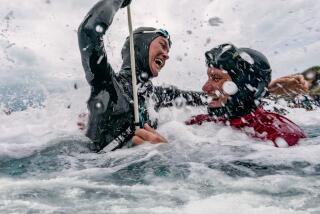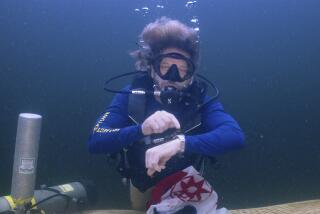High pressure
Bob Stiles, holding steady at about 100 feet, watched his friend shoot by “like a rocket.” Down the diver went, on a single breath, deeper and deeper, in a watery world that turned from blue to black, under the weight of what seemed an entire ocean.
“It was one of the most bizarre things I’ve ever seen,” said Stiles, 60, a Brentwood resident and former UCLA football star, who occasionally serves as a support diver for a man he refers to as superhuman. “I watched him just disappear into the abyss.”
Francisco “Pipin” Ferreras, who took the monumental plunge two Sundays ago off Cabo San Lucas, did not stop until he reached 558 feet. At that point, he inflated his balloon and shot upward, passing -- again, like a rocket -- a series of support divers in scuba gear, ultimately breaking the surface and gulping a breath of precious air.
He had spent 2 minutes 39 seconds underwater -- an eternity for breath-hold, or free, divers -- in reaching another of many milestones achieved over the years.
But setting a new “no-limits” world record, Oct. 12 beyond Baja California’s tip, was bittersweet. It came a year to the day after Ferreras’ wife, Audrey Mestre, drowned while attempting a similar dive in waters off the Dominican Republic. The diver, then 28, had been trying to break her husband’s record of 531 1/2 feet. She had reached her target depth of 561 feet but perished on her way up.
No-limits is an extreme category in which divers use a weighted sled attached to a cable to descend as quickly as possible, and a balloon, or lift bag, to propel themselves back up. Mestre and one of the support divers reportedly had trouble inflating her balloon. (Six support divers are usually positioned at various depths to monitor the dive and be on hand in case of trouble.)
Her final dive wasn’t recognized because she didn’t complete it, but a practice dive of 558 feet, completed a few days earlier, was approved as a world record by the International Assn. of Freedivers, one of the sport’s governing bodies founded by Ferreras.
(The International Assn. for the Development of Apnea, another governing body, does not consider it a record because it was a practice dive and some organizational requirements were not met.)
Ferreras, 41, a Cuban-born resident of Miami, chose the same depth for his “homage dive” in hopes of sharing the record with the woman he loved. He meditated on the deck of the boat for more than 20 minutes before going overboard.
“This was a very difficult and sad dive for me,” he told a freelance correspondent writing for the Miami Herald. “Audrey did the dive with me and helped me make it back.”
Ferreras did not return calls placed to his cellphone and residence. He has been avoiding the media because of the controversy surrounding the death of his wife. Infighting among his support team was intense in the months after the incident -- some members have quit or been fired -- and has yet to subside.
But in an interview with a Times reporter in 1996, after Ferreras had taken what was then a world-record plunge of 428 feet, he spoke candidly of the simple yet complex nature of an obscure activity practiced seriously by very few.
Breath-hold divers must equalize the pressure in their ears -- by holding their noses and blowing -- while descending. But because they do not breathe compressed air, they do not need to decompress and can ascend as quickly as they wish. (Scuba divers emerging from extreme depths, in order to avoid the sometimes fatal effects of rapid decompression, must do so slowly and make intermittent stops along the way.)
Free divers ride downward on the sled, wearing a device that measures depth. Once at the desired depth, they pull a tab to inflate the balloon and shoot back to the surface.
It helps that the 6-foot-3, 220-pound Ferreras is something of a human anomaly. His lungs can hold more than eight liters of air, twice that of the average adult, and he can hold his breath in a swimming pool for almost nine minutes. By the time he was 12 he could free dive more than 100 feet
But a lot happens to the body at such depths. Ferreras said the pressure becomes so intense that the blood in his arms and legs is forced to his chest and brain. It fills his lungs, preventing their collapse.
Below 300 feet he can no longer can relieve the pressure in his ears, so he removes his nose plug and lets water flow into and through his head, forcing what little air there is in his sinus cavities to his ears, relieving the pressure. When he ascends, at a rate of 13 to 15 feet per second, the blood leaves his lungs and returns to his arteries.
Beyond 400 feet, his heart slows to fewer than 10 beats per minute. Clarity of mind is difficult to maintain, he said. Kim McCoy, who filed the story for the Miami Herald, is an oceanographer who once used an electrocardiogram machine to monitor Ferreras’ heartbeat during a deep dive.
“As a clinician, if I saw those types of slowing of the heart and irregularity ... it would have been an emergency,” he told the Palm Beach Post.
Ferreras seemed to realize, after the 1996 dive, that there was a limit to how far even he could go. “I’m going to go to 500 feet and then I’m going to retire,” he said.
But that was just as his relationship with Mestre, a French marine biology student who shared his passion, was taking off. They became a team, supporting each other’s exploits, often before film crews.
Ferreras, whose latest dive was filmed by director James Cameron, sees no reason to stop. “He’s still going for it,” Stiles said. “This guy will not quit till he dies.”
More to Read
Sign up for Essential California
The most important California stories and recommendations in your inbox every morning.
You may occasionally receive promotional content from the Los Angeles Times.










